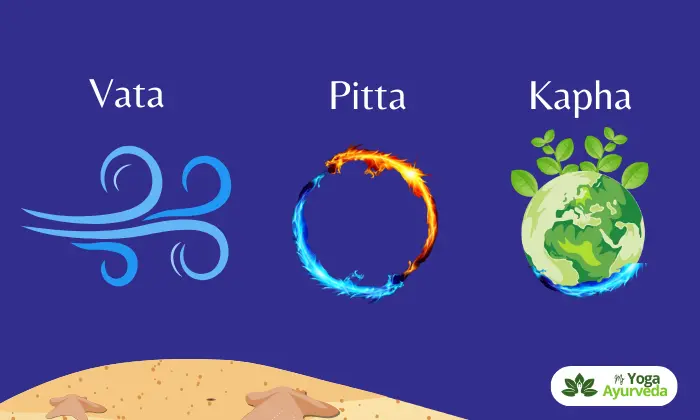
Written by Yoga Mentor Keshav, with facts sourced from Ancient Indian Ayurvedic and Yogic Textbooks, as well as scientific research.
Vata, Pitta, and Kapha are the three doshas that form the foundation of Ayurvedic understanding. It also mentions that these doshas represent the combinations of the five elements (earth, water, fire, air, and space) in the body. Additionally, it emphasizes that an individal’s constitution or prakriti is determined by the balance or imbalance of these doshas. All three doshas are present in each person at all times, but their proportion varies from person to person.

In Ayurveda, we discover the concept of “prakruti,” which unveils your unique constitution formed by the doshas during your creation. This natural blueprint guides your physical traits, mental tendencies, and your journey to lasting health.
Your prakruti could be predominantly pitta, with vata as a secondary dosha and a small amount of kapha. Maintaining balance for you would involve preserving this specific proportion of the doshas, as it is essential for your overall well-being.
Understanding and addressing imbalances in Doshas are integral to Ayurvedic diagnosis and treatment approaches.
Let’s navigate the realm of doshas, each embodying specific elements and qualities, as they interact within the intricate fabric of human experience.
Know your constitution here ! Know your Dosha here!
Vata, a dynamic blend of air and space, orchestrates the dance of movement and communication within you. From your breath’s rhythm to your circulation’s flow, Vata governs vital life processes gracefully.
Vata’s essence is marked by dryness, lightness, and mobility. Vata individuals have delicate muscles and minimal body fat, often leading to a slender or even underweight appearance.
Vata people are attracted to astringent food such as salads and vegetalbes but actually they need sweet, sour and salty tastes to balance Vata.
An imbalance in Vata can lead to dry skin, constipation, restlessness, and irregular sleep patterns. Excess Vata is also a major factor in PMS (pre-menstrual syndrome). On an emotional scale, heightened anxiety and a feeling of scatteredness become noticeable signs.
Grounding and stabilizing poses such as standing poses, forward bends, and gentle, flowing movements help calm the restless Vata energy.
Composed of the elements fire and water, Pitta governs digestion, metabolism, and transformation. It is associated with qualities like heat, energy, and intelligence. This dosha gifts intelligence and the power to bring about change.
Miracle Herb to Balance your Three Doshas
Pitta embodies qualities of heat, sharpness, oiliness, and spread. It ignites digestion’s fire, propels metabolism, and bestows mental acuity. Ambition, courage, and focused determination often characterize those influenced by Pitta.
Excessive Pitta can manifest as sensations of heightened heat, acidic reflux, heart burn, inflammation, and increased irritability. Emotionally, they may feel easily frustrated, impatient, and critical. This emotional turbulence becomes an indicator of Pitta imbalance.
For Pitta Dosha cooling and relaxing poses such as gentle backbends, twists, and seated forward folds help pacify the fiery Pitta energy.
Kapha, embodying earth and water, stands as the foundation of stability, structure, and nourishment. It creates a stronghold of both physical resilience and emotional support.
Kapha Dosha provides strength, endurance, and nourishment.
Kapha Dosha is characterized by the qualities of being heavy, cold, slow, oily, smooth, dense, and stable.It governs bodily functions related to structure, stability, and lubrication.
Kapha embodies attributes of heaviness, coldness, stability, and density. It plays a vital role in lubricating joints, nurturing tissues, and providing emotional well-being. Calmness, strength, and a compassionate demeanor often accompany Kapha’s realm.
When Kapha becomes imbalanced, signs of heaviness, congestion, and emotional attachment begin to surface. Individuals may experience symptoms such as sluggishness, weight gain, congestion, and excessive sleep.
A tendency toward complacency and resistance to change emerges as a pivotal indicator.
Balancing Kapha involves an active journey of invigoration.
For Kapha Dosha energizing and invigorating poses used in Power Yoga, Vinyas Yoga and Surya Namaskar, and backbends help stimulate the stagnant Kapha energy.
These 5 Yoga Poses Help to Reduce Weight
Maintaining balance in the Doshas is crucial for optimal health and well-being according to Ayurveda.
By understanding and balancing our Doshas, we can make informed decisions to support our overall well-being.
Use the knowledge of your prakriti as baseline, to see where you should be. Then look for your vikriti, your current imbalances.
You can use our Three Dosha Quiz to know your Vikriti. Just remember, “balance” doesn’t mean having the same amounts of vata, pitta, and kapha. It means keeping the right proportions of these three doshas according to your natural constitution.
What are Doshas in Ayurveda?
Doshas are the three vital energies or principles in Ayurveda: Vata, Pitta, and Kapha. They govern various functions and processes in the body and mind.
What are the three Doshas?
The three Doshas are Vata, Pitta, and Kapha. Vata represents movement, Pitta represents metabolism and transformation, and Kapha represents structure and stability.
How do Doshas influence our health?
Doshas influence our physical, mental, and emotional well-being. When in balance, they promote health, but imbalances can lead to disease or discomfort.
Can Dosha imbalances cause health problems?
Yes, imbalances in the Doshas can disrupt the body’s natural equilibrium and manifest as physical or mental health problems.
How can I determine my dominant Dosha?
You can determine your dominant Dosha through self-reflection, observing your physical and mental attributes, consulting with an Ayurvedic practitioner or taking Three Dosha Quiz Here!
Are Doshas fixed or can they change over time?
Doshas can change over time due to various factors like diet, lifestyle, environment, and age. They are influenced by both internal and external factors.
Can I have a combination of two dominant Doshas?
Yes, it is possible to have a combination of two dominant Doshas, known as dual Dosha types. For example, someone can be Vata-Pitta or Pitta-Kapha dominant.
How can I balance my Doshas naturally?
Balancing Doshas involves adopting a personalized approach based on your dominant Dosha. This includes following a balanced diet, engaging in suitable exercise, practicing stress management techniques, and incorporating Ayurvedic therapies.


